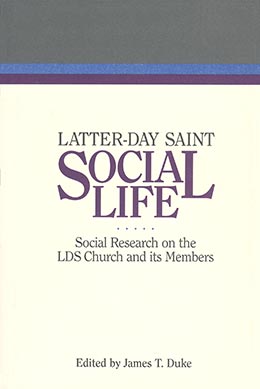Religiosity, Mental Health, and Latter-day Saints: A Preliminary Review of Literature (1923–95)
Daniel K Judd
Daniel K Judd, “Religiosity, Mental Health, and Latter-day Saints: A Preliminary Review of Literature,” in Latter-day Saint Social Life: Social Research on the LDS Church and its Members (Provo, UT: Religious Studies Center, Brigham Young University, 1998), 473–498.
Daniel K Judd is assistant professor of ancient scripture at Brigham Young University. This article was originally published in Mormon Identities in Transition, ed. Douglas Davies. London and New York: Cassell, 1996, pp. 112–24; reprinted with permission.
Abstract
This chapter includes a brief overview of research concerning the mental health of members of The Church of Jesus Christ of Latter-day Saints. Analysis of the data indicates that Latter-day Saints who live their lives consistent with their religious beliefs experience greater general well-being and marital and family stability, and less delinquency, depression, anxiety, and substance abuse than those who do not. This review of research also concludes that there is very little support for the assertion made by some that religious belief, practice, or affiliation is antithetical to mental health.
Introduction
The relationship of religion and mental health has long been an issue in the social sciences. The sometimes controversial nature of the discussion is true for the relationship of religion and mental health in general and the mental health of the membership of The Church of Jesus Christ of Latter-day Saints (Mormons) in particular. Many have argued for the positive influence of religion while others have argued for the opposite. William James (1929, pp. 516–17) wrote the following:
We and God have business with each other; and in opening ourselves to His influence our deepest destiny is fulfilled. The universe, and those parts of it which our personal being constitutes, takes a turn genuinely for the worse or the better in proportion as each one of us fulfills or evades God’s commands.
Psychologist Albert Ellis (1980, p. 637) represents those who argue for the negative influence of religiosity on mental health:
Religiosity is in many respects equivalent to irrational thinking and emotional disturbance. . . . The elegant therapeutic solution to emotional problems is to be quite unreligious. . . . The less religious they are, the more emotionally healthy they will be.
The apparent conflict between the assertions represented by James and Ellis has served as an invitation for many social scientists to examine these statements in the light of research evidence.
Previous Reviews of Religiosity and Mental Health Literature
Lea (1982), Bergin (1983), and I (Judd 1986) have published literature reviews concerning the relationship of religiosity and mental health through 1977, 1979, and 1985 respectively. Levin and Vanderpool (1987); Gartner, Larson, and Allen (1991); and Larson et al. (1992) have also published noncomprehensive reviews. [1] I am presently completing a major research project that will update the list of religiosity and mental health literature through March 1996. This article is a brief report of my preliminary findings of all research concerning the relationship of religiosity and mental health as well as a specific focus on various descriptions of the mental health of the membership of The Church of Jesus Christ of Latter-day Saints. [2]
In a previous literature review of religiosity and mental health research (Judd 1986), I reported the outcomes of a total of 167 studies (182 outcomes). This initial study was a review of the research conducted in the sixty-two-year period between January 1923 and March 1985. This study represented data gathered from over two hundred thousand subjects. Thirty percent of the studies reviewed indicated a negative relationship (religion facilitating mental problems), 32 percent a positive relationship (religion conducive to positive mental health), 33 percent a neutral relationship, and 5 percent a curvilinear relationship. [3] Table 17.1 is a graphic illustration of these percentages.

For the most part, these data are ambiguous as to the support or refutation of either a positive or negative relationship of religion and mental health. However, in the process of completing this initial study, I noted a positive trend in the research beginning in the late seventies and continuing through the eighties. Out of twenty-three studies conducted between 1980 and 1985, 61 percent (fourteen studies) reported a positive relationship between religiosity and mental health, 26 percent (six studies) a neutral relationship, 9 percent (two studies) a curvilinear relationship, and 4 percent (one study) a negative relationship. These data are represented in table 17.2.
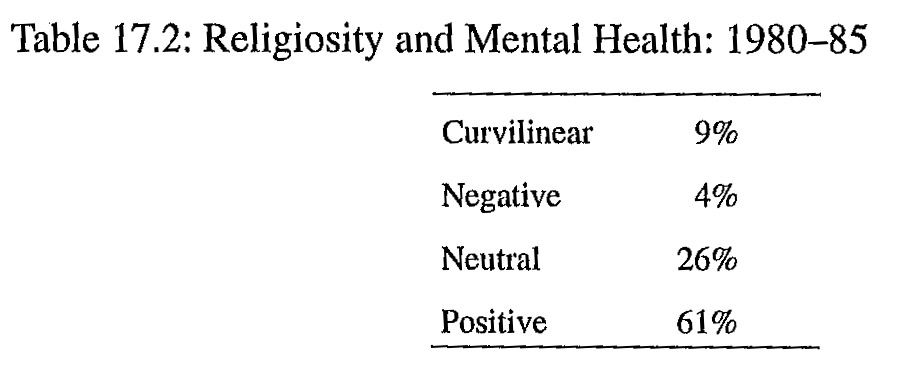
A Decade Review (1985–95)
My initial literature review of the research published between March 1985 and March 1995 generated 373 specific studies that focused on the relationship between religiosity and mental health. My data gathering methods consisted of the following:
(1) A computer search of PsychLIT [4] for the period between March 1985 and January 1995 for publications dealing with differing aspects of religion and mental health/
(2) The “ancestry” method, which involved examining the reference citations of recent articles for related studies, was also employed. This method served as a check for articles which may not have been included in the computer search. It also generated studies that were included in various symposia and reference works.
(3) The noncomprehensive reviews reported by Levin and Vanderpool (1987); Gartner, Larson, and Allen (1991); and Larson et al. (1992) were examined to identify the specific measures of religiosity and mental health utilized and the sizes and descriptions of the samples.
(4) For the study/
Preliminary Results of Decade Review
A preliminary examination of the 373 studies (529 outcomes) published between 1985 and 1995 revealed that 59 percent (311 outcomes) showed a positive relationship between religiosity and mental health, 13 percent (67 outcomes) a negative relationship, and 26 percent (138 outcomes) a neutral relationship. These data are summarized in table 17.3.
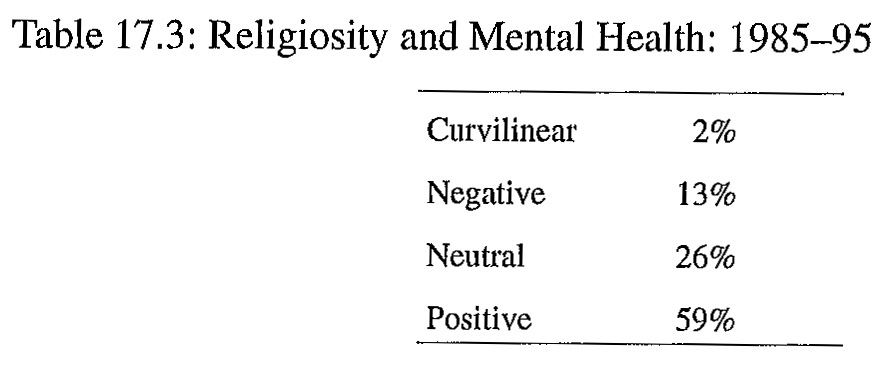
The Positive Relationship of Religiosity and Mental Health
The positive trend noted in my earlier study (Judd 1986) is validated in the analysis of the present data. There continues to be little support for the assertion that religiosity is antithetical to mental health. Eighty-five percent of the outcomes reviewed in this present investigation (1985–95) either indicated a positive (59 percent) or a neutral (26 percent) relationship between religiosity and mental health, thus contradicting the negative assertions made by Ellis and others. Not only is there little support for the assertion of a negative relationship between religiosity and mental health, but there is sufficient support for the assertion of a positive relationship. These statistics appear to be much less ambiguous than the “mixed and even contradictory findings” reported by Gartner, Larson, and Allen (1991, p. 6). The conclusions based on the analysis of the data in the present study are consistent with those of Larson et al. (1992, p. 557) who reported a “positive relationship between religious commitment and mental health” in the “great majority” of the 139 studies reviewed in the American Journal of Psychiatry and the Archives of General Psychiatry between the years of 1978 and 1989.
Philosophical Assumptions and Research Outcome
While the specific reason(s) for this positive trend is/
The issues are not simply empirical; they pertain also to the frame of reference of human sciences and scientists, as illustrated in the following:
1. Values and ideology influence theoretical axioms. Conceptions of personality and psychopathology have subjective as well as empirical bases, as do rationales for intervention and goals of outcome.
2. In addition to this conceptual bias, mental health literature and education are limited by their minimal appreciation for the religious subcultures of our society.
3. The foregoing conceptual and attitudinal biases have become a part of empirical inquiry, so religious factors are either excluded from measurement and manipulation or are included in such a way as to prejudice the results.
An example of how theoretical assumptions can influence research outcome can be found in the construction of one of the most widely utilized tools in clinical psychology, the MMPI (Minnesota Multiphasic Personality Inventory). One of the research scales of the MMPI is known as the Ego Strength Scale, which is described by Jane Duckworth (1979, p. 203) as “one of the best indicators of psychological health on the MMPI.” Barron (1953, p. 323) utilized the following questions as a part of his scale:
1. Everything is turning out just like the prophets in the Bible said it would.
2.1 have had some very unusual religious experiences.
3. Christ performed miracles such as changing water into wine.
4.1 pray several times every week.
If respondents answer yes to any or all of the above questions, it scores against their ego strength score. Some clients who are of a particular religious orientation would appear less functional than those who do not have such beliefs. Obviously, Barron (1953) presupposes that these forms of religious belief and practice have a negative influence on an individual’s ego strength. Other scales on the MMPI that I have identified as having an anti-religious bias are the Dependency, Dominance, Prejudice, Social Status, and Control scales.
From this example it becomes quite clear that one must analyze the assumptions on which the research is based before drawing definitive conclusions.
Specific Outcomes (1985–95)
This most recent analysis of data (1985–95) indicates that high scores on measures of religiosity (activity, attitude, affiliation, and belief) are facilitative of marital and family stability, adjustment, and personal well-being. This most recent analysis also indicates that those who score high on measures of religiosity show the highest positive correlation with measures of mental health. Also, those who score higher on scales of “intrinsic” religiosity score better on measures of mental health than those with an “extrinsic” religious orientation. [5] There also appears to be little difference in measures of mental pathology with respect to religious affiliation.
The 13 percent of the total studies which indicated negative relationships between religiosity and mental health were observed in a random pattern across the various mental health variables. The only possible significant pattern of a negative relationship between religiosity and mental health was observed in the area of prejudice. A possible explanation for this result could be that many religions have voiced strong opposition to such issues as alcohol/
Mental Health of the Latter-day Saints
Of the 540 studies published between 1923 and 1995, I was able to locate fifty-five studies that dealt specifically with LDS samples. Of these fifty-five studies (seventy-three outcomes), 70 percent of the outcomes indicated a positive relationship between religiosity and mental health variables, 4 percent negative, and 24 percent neutral. These data are illustrated in table 17.4.
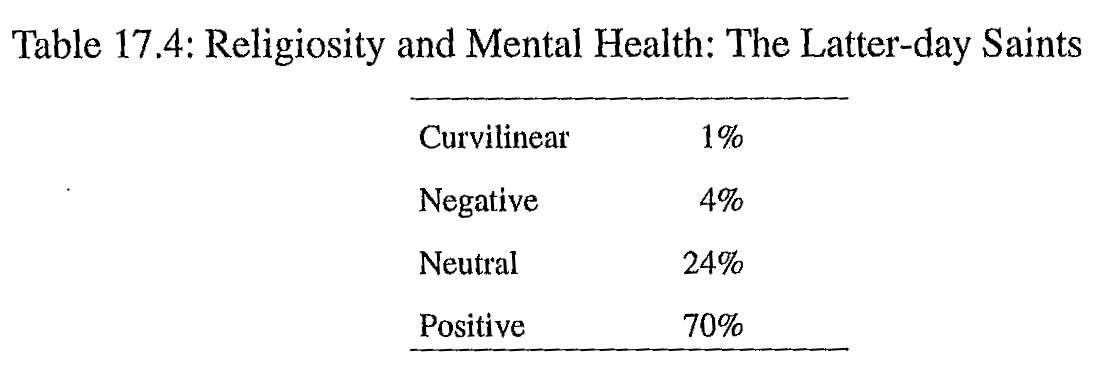
While there were many anecdotal reports and essays, only the following fifty-five studies were found to be consistent with the pre-established criteria. For the sake of brevity I have included only the name of the first author. The full reference citation for each of these studies can be found in the reference section of this paper.
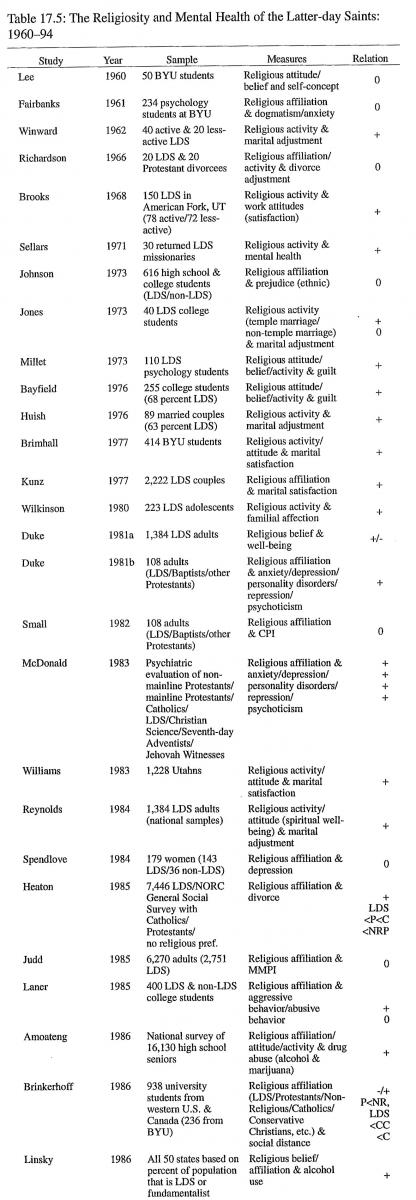

This review of research concerning Mormonism and mental health represents the responses from over ninety-six thousand Latter-day Saints from 1960 to 1995. Religious variables were classified specifically (or in combination) as religious affiliation, activity, attitude, or belief. Mental health variables were defined in terms ranging from anxiety, depression, and schizophrenia to marital satisfaction, self-esteem, and irrational beliefs. The following are general themes which were observed from an analysis of the data.
Mormonism and Prejudice
Three of the fifty-five studies focusing on Mormonism and mental health indicated a negative relationship. Two of the three studies reporting negative results were in the areas of dogmatism and social distance. Emery (1992, p. 1) found that “Mormons were significantly more dogmatic and more traditional in their attitudes toward women than were Protestants.”
Gender Issues
An analysis of this study reveals that two of the specific reasons for Latter-day Saints scoring higher on the dogmatism scale than Protestants have to do with Latter-day Saint beliefs concerning women working outside the home and birth control. Leaders of the LDS Church have counseled LDS couples not to unduly restrict the size of their families and urged mothers not to work outside the home except in extenuating circumstances (Benson 1987, pp. 1–13). While some claim that the LDS lifestyle limits women’s freedom and happiness, research evidence suggests otherwise.
Johnson, Duke, Eberley, and Sartain (1988, p. 259) examined the impact of women’s employment on the marital happiness of 313 LDS couples. Their study indicated that while LDS men were happiest when their wives were working full-time, the response from LDS women was different:
[For wives] there was a significant difference in global marital happiness with traditional homemakers being the most happy, followed by full-time employed wives. Wives working part-time were the least happy. When wives identified themselves as strong Church members and the age of their children was added as a variable, results showed traditional homemakers with preschool children had higher global marital happiness, consensus, and sexual satisfaction.
Racial Issues
Kunz and Oheneba-Sakyi (1989), also used the “Borgardus Social Distance Scale” to show Mormons’ “social distance” scores decreased dramatically after a revelation was announced in 1978 extending Black members the Priesthood on an equal basis with whites. Their study also indicated that the decrease in social distance scores was maintained over a ten-year period. These studies support the assertion that “prejudice” among Mormons is more a matter of theology than intolerance.
Affiliation and Prejudice
Brinkerhoff (1986), in a comparative study, found that Protestant subjects scored the lowest (least prejudiced) on the Bogardus Social Distance Scale. Latter-day Saints and those reporting “no affiliation” showed the next lowest social distance scores followed by conservative Christians and then by Catholics.
Mormonism and the MMPI
In a previous paper, I (Judd 1986) combined and graphically illustrated mean scores from all MMPI research dealing with specific religious denominations. Included in the data set were scores for 2,560 Latter-day Saints. Tables 17.6 (male) and 17.7 (female) contain the mean scores for the denominations surveyed. Inasmuch as the MMPI is normalized separately for males and females, respective summaries are reported.
While most MMPI data relative to LDS samples has been found to be either positive or neutral (see Judd 1986; Rose 1986), Masters (1991) reported partially negative results. Out of the thirteen MMPI scales Masters investigated in a three-year follow-up survey of sixty LDS respondents, four showed negative change (Lie, Correction, Depression, and Hysteria). Seven scales indicated positive change (Frequency/
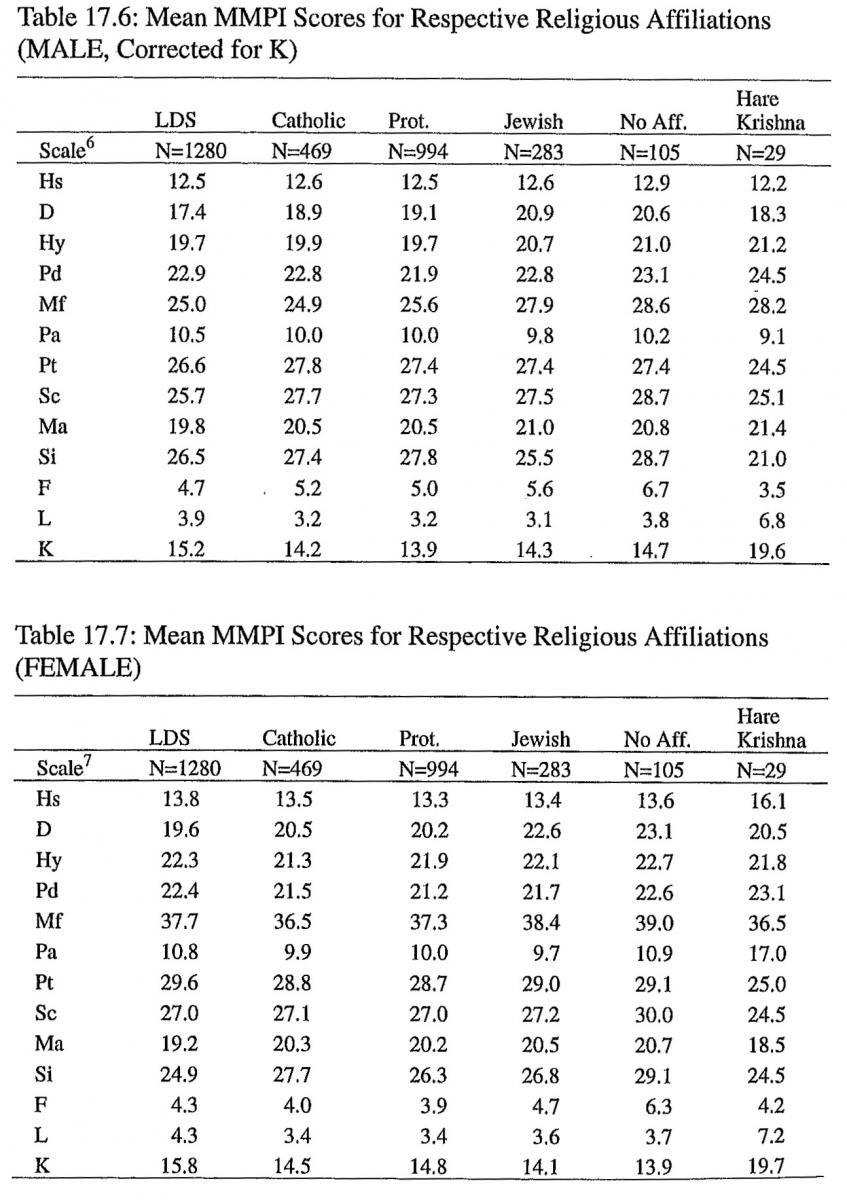 See Table 17.6 for Note [6], and Table 17.7 for Note [7].
See Table 17.6 for Note [6], and Table 17.7 for Note [7].
Mormonism and Depression
In 1858 a writer from Harper’s Weekly traveled to Utah and made the observation that the Latter-day Saint lifestyle turned LDS women into “haggard, weary, slatternly women, with lackluster eyes and wan, shapeless faces, hanging listlessly over their gates, or sitting idly in the sunlight, perhaps nursing their yelling babies—all such women looking alike depressed, degraded, miserable, hopeless, soulless” (G. L. Bunker and D. Binton, as cited in Judd 1987, p. 150). In 1860, Dr. Robert Bartholomew, the assistant surgeon of the United States Army, visited Utah and described LDS men as having “an expression of compounded sensuality, cunning suspicion, and a smirking self-conceit” (G. L. Bunker and D. Binton, as cited in Judd 1987, p. 150).
While many anecdotal descriptions (such as the ones above), essays (see Burgoyne and Burgoyne 1978), and media specials have discussed the detrimental effects of the LDS lifestyle on mental health (especially that of LDS women), few have any grounding in research evidence. None of the studies included in this analysis that included depression as one of its variables indicated support for an unhealthy relationship between Mormonism and depression. [8]
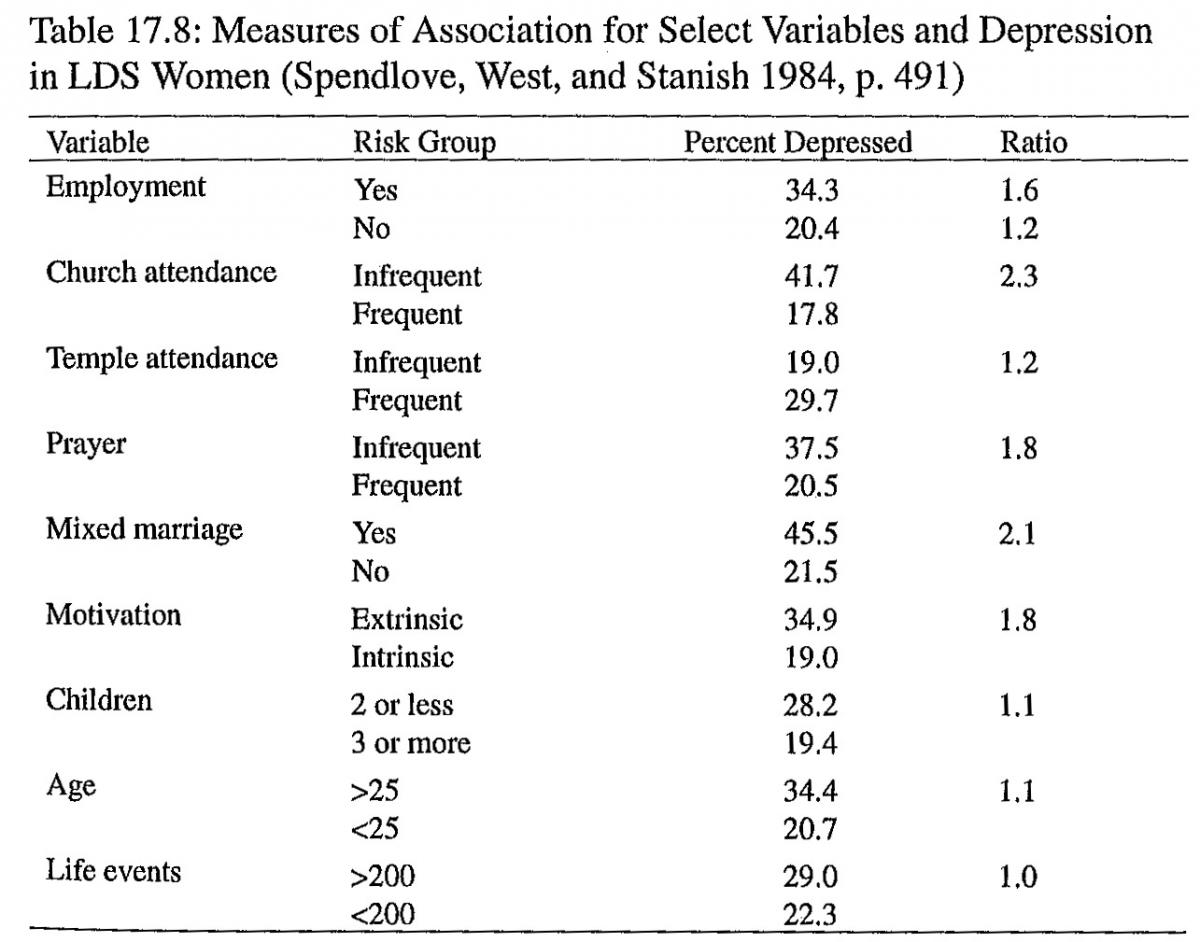
Spendlove, West, and Stanish (1984, p. 491) looked specifically at LDS women and depression. In a comparison of LDS and non-LDS women living in Salt Lake City, Utah, they concluded that “no difference in the prevalence of depression was noted.” Table 17.8 graphically illustrates some comparisons within the LDS sample.
In a comparison of 3,835 Catholic, Protestant, and LDS university students, Jensen, Jensen, and Wiederhold (1993, p. 1158) reported that “women in the LDS denomination reported less depression than women in the other denominations, but scores for LDS men were similar to those of Catholics and Protestants.”
Mormonism and Family Life
Fifteen of the fifty-five studies reviewed in this analysis looked at factors related to the LDS family. Ten of these fifteen studies reported positive results on scales of marital satisfaction while five indicated neutral results. Wilkinson (1980) reported LDS samples to have positive scores on scales of family affection.
Heaton and Goodman (1985, p. 343) reported that when compared to those of no religious preference, “Catholics, Protestants, and Mormons are more likely to marry, less likely to divorce, more likely to marry following divorce, and they have larger families.” A comparison between the religious groups revealed that “Mormons tend to have the highest rate of marriage and fertility, but the lowest rates of divorce.” Note table 17.9 for a comparison of Catholics, Protestants, Latter-day Saints, and those indicating no religious preference with respect to divorce.
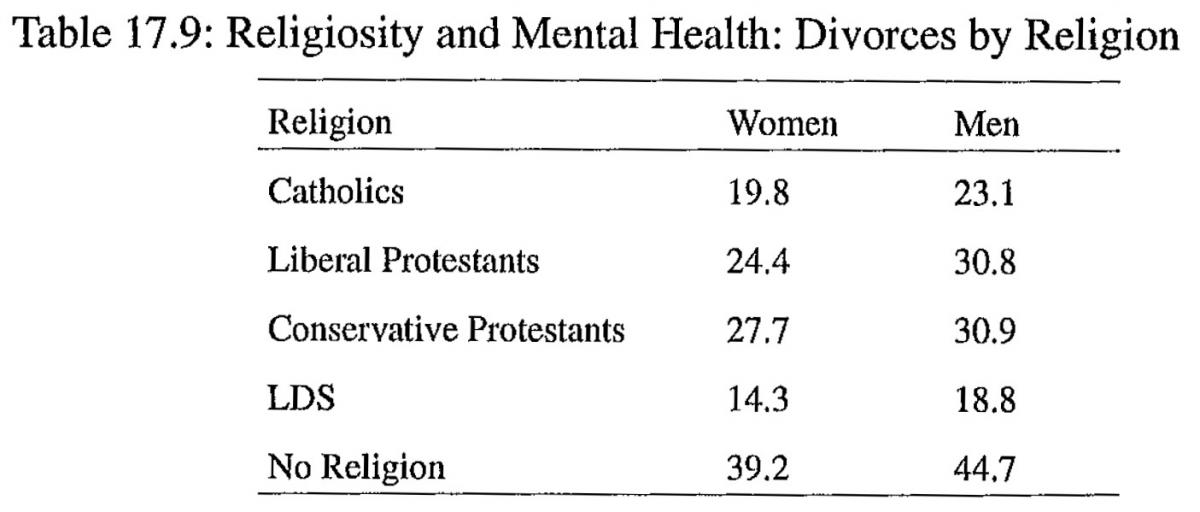
Latter-day Saints who marry in a temple ceremony are less likely to divorce than those married outside the temple (Thomas 1983). Heaton (1988) reports that among men and women who were married in the temple, 6 percent of the men and 7 percent of the women had later been divorced. Among men and women not married in the temple, the data indicated that 28 percent of the men and 33 percent of the women have eventually been divorced. Table 17.10 illustrates the comparison between Latter-day Saints married in the temple and Latter-day Saints who marry outside of the temple who later divorce.

Sex
Miller and Olson (1987, 1988) found the prevalence of premarital sexual intercourse to be less with LDS than with non-LDS teenagers. Beck, Cole, and Hammond (1991) found young adult Latter-day Saints, along with young adult Pentecostals and Jehovah Witnesses, to have the “lowest likelihoods of premarital sex” when compared with mainline Protestant youth.
Delinquency
Chadwick and Top (1993) found that LDS religiosity is a significant deterrent to delinquency. Interestingly, this statistic held true for Latter-day Saint youth even when they were not in a “highly religious climate.” In this study, religiosity was measured in terms of belief, attitude, and activity, while delinquency was measured in terms of “acts against others,” “victimless delinquency behavior” (i.e., premarital sex), and “delinquency against property.”
Mormonism and Substance Abuse
Of the fifty-five studies in this review, seven dealt with religiosity and substance abuse. Of the seven studies, four concluded that LDS belief, attitude, or activity contributed to lower rates of substance abuse. The remaining three of the seven studies indicated no significant relationship between Mormonism and substance abuse. Hawks and Bahr (1992, p. 1) concluded that “for all religions except Jews, a lower percentage of Utahns [Utah Latter-day Saints] used alcohol than their national counterparts.” Table 17.11 is a summary of these data. While Latter-day Saints differed from their religious counterparts in the use of alcohol, they did not differ in the quantity of alcohol consumed if they did drink.
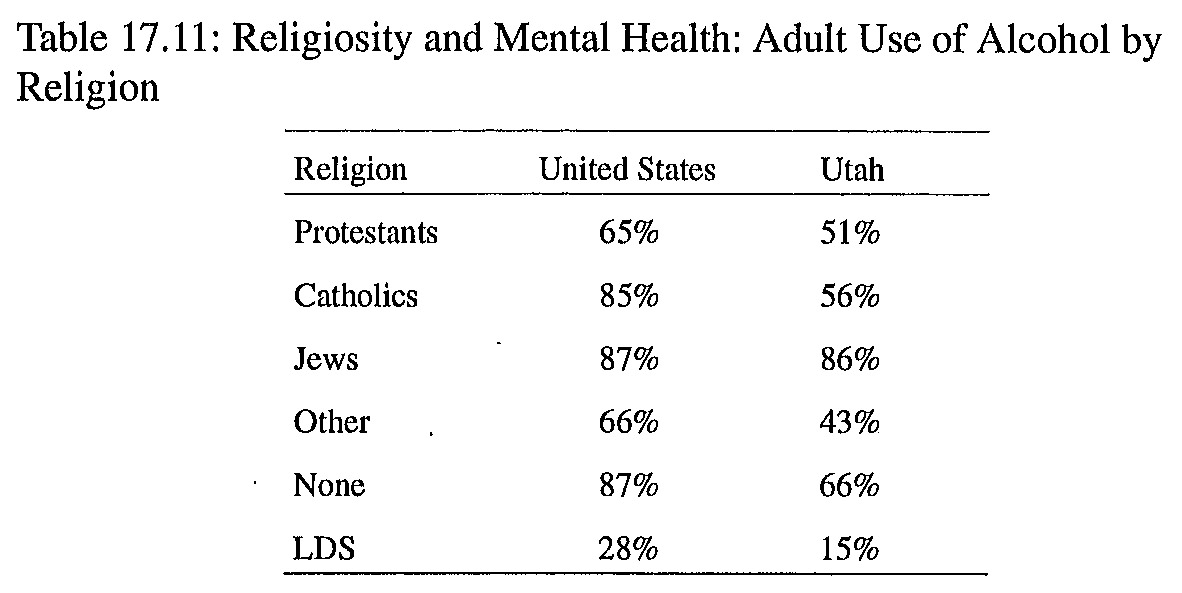
Mormonism and Well-Being
Nine of the fifty-five studies dealing with Mormonism and mental health focused on various dimensions of well-being (six positive outcomes/
Duke and Johnson (1981, p. 16) compared LDS and national samples and concluded that “Mormon respondents, on the whole, have a higher level of overall happiness than the American populace.” Within the LDS sample, Duke and Johnson (1981, p. 23) noted that “the greater the religiosity the greater the happiness.” The measures of religiosity which best demonstrated their conclusion were the “beatitudes factor” (a measure of virtues like patience, kindness, etc.) and the “knowledge of the scriptures” variable.
Conclusions
This study has provided a brief summary of research concerning the relationship of religion and mental health from 1923–95. Specifically, this study has focused on the mental health of the members of The Church of Jesus Christ of Latter-day Saints. General analysis of the studies of the relationship of mental health with religion in general and Mormonism in particular supports the following conclusions:
1. There is little support for the assertion that religiosity is antithetical to mental health.
2. The data indicated that individuals who live their lives consistent with their religious beliefs experience greater general well-being, marital and family stability, and less delinquency, depression, anxiety, and substance abuse.
3. There are few differences in measures of mental pathology with respect to religious affiliation.
4. Researcher presuppositions (theistic and atheistic) can influence the outcome of their studies.
5. There exists a change in the number of positive and negative studies over time. Earlier studies show a greater incidence of negative studies while more recent studies report more positive relationships.
6. While a positive trend is noted, there continue to exist some studies where negative results are reported. While some of these negative outcomes can indeed be a result of research bias, there are such phenomena as unhealthy forms of religious devotion. More research needs to be done identifying healthy and unhealthy forms of religious devotion.
Though I recognize the importance of objectivity, I am enthused with the most recent (1985–95) findings supporting a positive relationship between religiosity and mental health. I concur with William James (1929, p. 516) that “we and God do have business with each other” and that mankind can be blessed by living lives that are consistent with the commands of God.
References
Allport, G. W. and J. M. Ross. 1967. “Personal Religious Orientation and Prejudice.” Journal of Personality and Social Psychology 5:432–43.
Amoateng, A. Y. and S. J. Bahr. 1986. “Religion, Family, and Adolescent Drug Abuse.” Sociological Perspectives 29:53–76.
Bahr, Stephen J. 1994. “Religion and Adolescent Drug Use: A Comparison of Mormons and Other Religions.” Pp. 115–37 in Contemporary Mormonism: Social Science Perspectives, edited by Marie Cornwall, Tim B. Heaton, and L. A. Young. Urbana, IL: University of Illinois Press.
Bahr, Stephen J., R. D. Hawks, and G. Wang. 1993. “Family and Religious Influences on Adolescent Substance Abuse.” Youth and Society 24:443–65.
Bayfield, M. L. 1976. “Religious Commitment and Meaning in Life.” Utah State University, Logan, UT Unpublished manuscript.
Barron, F 1953. “An Ego-Strength Scale which Predicts Response to Psychotherapy.” Journal of Consulting Psychology 17:327–33.
Beck, S. H., B. S. Cole, and J. A. Hammond. 1991. “Religious Heritage and Premarital Sex: Evidence from a National Sample of Young Adults.” Journal for the Scientific Study of Religion 30:173–80.
Benson, EzraTaft. 1987. To the Mothers in Zion. Salt Lake City: The Church of Jesus Christ of Latter-day Saints.
Bergin, Allen E. 1983. “Religiosity and Mental Health: A Critical Reevaluation and Meta-Analysis.” Professional Psychology: Research and Practice 14:170–84.
Bergin, Allen E., K. S. Masters, and P. S. Richards. 1987. “Religious and Mental Health Reconsidered: A Study of an Intrinsically Religious Sample.” Journal of Counseling Psychology 34:197–204.
Bergin, Allen E., R. D. Stinchfield, T. A. Gaskin, K. S. Masters, and C. E. Sullivan. 1988. “Religious Life-Styles and Mental Health: An Exploratory Study.” Journal of Counseling Psychology 35:91–98.
Brimhall, Barry William. 1977. “An Empirical Test: The Relationship between Marital Satisfaction and the Employment of Four Religious Principles by the Marriage Partners.” Brigham Young University, Provo, UT. Unpublished manuscript.
Brinkerhoff, Merlin B. and Marlene M. Mackie. 1986. “The Applicability of Social Distance for Religious Research: An Exploration.” Review of Religious Research 28:151–67.
Brooks, R. M. 1968. “The Relationship between Religious Behavior and Some Work Attitudes among Active and Inactive Mormons in American Fork, Utah.” Brigham Young University, Provo, UT. Unpublished manuscript.
Browning, P. K. 1988. Mormon Marital Satisfaction: A Perceived Congruence of Expectations and Outcomes and Factors Related to Satisfaction and Expectations [CD-ROM]. Abstract from: ProQuest File: Dissertation Abstracts Item: 8723149. Burgoyne, R. H. and R. W.
Burgoyne. 1978. “Belief Systems and Unhappiness: The Mormon Woman Example.” Dialogue 11:48–53.
Chadwick, Bruce A. and Brent L. Top. 1993. “Religiosity and Delinquency among LDS Adolescents.” Journal for the Scientific Study of Religion 32:51–67. Also in this volume.
Condie, S. J. 1978. “Role Profit and Marital Satisfaction throughout the Family Life Cycle.” Journal of Comparative Family Studies 9:557–67. Also in this volume.
Cornwall, Marie. 1989. “The Determinants of Religious Behavior: A Theoretical Model and Empirical Test.” Social Forces 68:572–92. Also in this volume.
Duckworth, J. C. 1979. MMPI Interpretation Manual for Counselors and Clinicians. Muncie, IN: Accelerated Development.
Duke, James T. and Barry L. Johnson. 1981a. “The Dimensions of Religiosity among Mormons and Their Consequences in Family Relationships.” Brigham Young University, Provo, UT. Unpublished manuscript.
———. 1981b. “Happiness in Mormon Families: A Multivariate Analysis.” Brigham Young University, Provo, UT. Unpublished manuscript.
Ellis, A. E. 1980. “Psychotherapy and Atheistic Values: A Response to A. E. Bergin’s ‘Psychotherapy and Religious Values’.” Journal of Consulting and Clinical Psychology 48:635–39.
Ellison, Christopher G. 1991. “Religious Involvement and Subjective Well-Being.” Journal of Health and Social Behavior 32:80–99.
Emery, S. 1992. A Four-Dimensional Analysis of Sex Role Attitudes in a Mormon Population: Personal Control, Self-Esteem, Dogmatism, and Religious Affiliation [CD-ROM]. Abstract from: ProQuest File: Dissertation Abstracts Item: 9131175.
Fairbanks, R. R. 1961. “Manifest Anxiety as Related to Dogmatism and the Perception of Persons at Brigham Young University.” Brigham Young University, Provo, UT. Unpublished manuscript.
Gartner, J., D. B. Larson, and G. D. Allen. 1991. “Religious Commitment and Mental Health: A Review of the Empirical Literature.” Journal of Psychology and Theology 19:6–25.
Glenn, J. E. 1988. “Cohesion in a Utah Sample of Latter-day Saint Couples.” Brigham Young University, Provo, UT. Unpublished manuscript.
Hawks, R. D. and S. J. Bahr. 1992. “Religion and Drug Use.” Journal of Drug Education 22:1–8.
Hawks, R. D., S. J. Bahr, and G. Wang. 1994. “Adolescent Substance Abuse and Codependence.” Journal of Studies on Alcohol 55:261–68.
Heaton, Tim B. 1988. “Four C’s of the Mormon Family: Chastity, Conjugality, Children, and Chauvinism.” In The Religion and Family Connection, edited by Darwin L. Thomas. Provo, UT: Religious Studies Center, Brigham Young University.
Heaton, Tim B. and Kristen L. Goodman. 1985. “Religion and Family Formation.” Review of Religious Research 26:343–59.
Huish, A. L. 1976. “The Relationship of Family Religious Ritual in the Home and the Marital Adjustment of Young Couples.” Utah State University, Logan, UT. Unpublished manuscript.
James, W. 1929. The Varieties of Religious Experience. New York: Long.
Jensen, L. C, J. Jensen, and T. Wiederhold. 1993. “Religiosity, Denomination, and Mental Health among Young Men and Women.” Psychological Reports 72:1157–58.
Johnson, Barry L., S. Eberly, James T. Duke, and D. H. Sartain. 1988. “Wives’ Employment Status and Marital Happiness of Religious Couples.” Review of Religious Research 29:259–70.
Johnson, M. A. 1973. “A Comparison of Mormon and Non-Mormon Ethnic Attitudes.” Brigham Young University, Provo, UT. Unpublished manuscript.
Jones, R. S. 1973. “Factors Associated with Marital Adjustment of Young Mormon Married College Students.” Utah State University, Logan, UT. Unpublished manuscript.
Judd, Daniel K. 1985. “Religiosity and Mental Health: A Literature Review 1928–1985.” Brigham Young University, Provo, UT. Unpublished manuscript.
———. 1986. “Religious Affiliation and Mental Health.” AMCAP Journal 12:71–108.
———. 1987. “‘Not As the World Giveth . . .’ : Mormonism and Popular Psychology.” Pp. 149–62 in To Be Learned is Good If . . ., edited by R. Millet. Salt Lake City: Bookcraft.
Kranich, R. S., P. J. Riley, and A. Leffler. 1988. “Perceived Stress among Nonmetro-politan Utah Residents.” [CD-ROM]. Lifestyles 9:281–96. Abstract from: Silver Platter File: Sociofile Item: 89V0036.
Kunz, P. R. and Stan L. Albrecht. 1977. “Religion, Marital Happiness, and Divorce.” International Journal of Sociology of the Family 7:227–32.
Kunz, P. R. and Yaw Oheneba-Sakyi. 1989. “Social Distance: A Study of Changing Views of Young Mormons toward Black Individuals.” Psychological Reports 65:195–200.
Laner, M. R. 1985. “Unpleasant, Aggressive, and Abusive Activities in Courtship: A Comparison of Mormon and Non-Mormon College Students.” Deviant Behavior 6:145–68.
Larson, D. B., K. A. Sherrill, J. S. Lyons, F. C. Craigie Jr., S. B. Thielman, M. A. Green wold, and S. S. Larson. 1992. “Associations between Dimensions of Religious Commitment and Mental Health Reported in the American Journal of Psychiatry and Archives of General Psychiatry: 1978–1989.” American Journal of Psychiatry 149:557–59.
Lea, G. 1982. “Religion, Mental Health, and Clinical Issues.” Journal of Religion and Health 21:336–51.
Lee, W. G. 1960. “A Study of the Relationship between Self-Concept and Religious Interest of Fifty College Students.” Brigham Young University, Provo, UT. Unpublished manuscript.
Levin, Jeffrey S. and H. Y. Vanderpool. 1987. “Is Frequent Religious Attendance Really Conducive to Better Health?: Toward an Epidemiology of Religion.” Social Science and Medicine 24:589–600.
Linsky, A. S., J. P. Colby, and M. A. Straus. 1986. “Drinking Norms and Alcohol-Related Problems in the United States.” Journal of Studies on Alcohol 47:384–93.
Lund, D. A., M. S. Caserta, and M. F. Dimond. 1988. “A Comparison of Bereavement Adjustments between Mormon and Non-Mormon Older Adults.” Journal of Religion and Aging 5:75–92.
MacKie, M. M. and M. B. Brinkerhoff. 1986. Blessings and Burdens: The Reward-Cost Calculus of Religious Denominations. [CD-ROM]. Canadian Journal of Sociology 11:157–81. Abstract from SilverPlatter File: Sociofile Item: 86-R0330.
Markstrom-Adams, C, G. Hofstra, and K. Dougher. 1994. “The Ego-Virtue of Fidelity: A Case for the Study of Religion and Identity Formation in Adolescence.” Journal of Youth and Adolescence 23:453–69.
Masters, K. S., A. E. Bergin, E. M. Reynolds, and C. E. Sullivan. 1991. “Religious Life-Styles and Mental Health: A Follow-Up Study.” Counseling and Values 35:211–24.
McDonald, C. B. and J. B. Luckett. 1983. “Religious Affiliation and Psychiatric Diagnoses.” Journal for the Scientific Study of Religion 22:15–37.
Miller, Brent C, R. B. Christensen, and T. D. Olson. 1987. “Adolescent Self-Esteem in Relation to Sexual Attitudes and Behavior.” Youth and Society 19:93–111.
Miller, Brent C. and T. D. Olson. 1988. “Sexual Attitudes and Behavior of High School Students in Relation to Background and Contextual Factors.” Journal of Sex Research 24:194–200.
Millet, Robert L. 1973. “The Relationship of Religious Commitment to Guilt.” Brigham Young University, Provo, UT. Unpublished manuscript.
Reynolds, R. W. 1984. “Level of Marital Adjustment and Spiritual Well-Being among Latter-day Saints.” Brigham Young University, Provo, UT. Unpublished manuscript.
Richards, P. S., S. A. Smith, and L. F. Davis. 1989. “Healthy and Unhealthy Forms of Religiousness Manifested by Psychotherapy Clients: An Empirical Investigation.” Journal of Research in Personality 23:506–24.
Richards, P. S., L. Owen, and S. Stein. 1993. “A Religiously Oriented Group Counseling Intervention for Self-Defeating Perfectionism: A Pilot Study.” Counseling and Values 37:96–104.
Richardson, S. L. 1966. “Three Aspects of Post Divorce Social Adjustment in Mormon Utah and Protestant Nevada.” Brigham Young University, Provo, UT. Unpublished manuscript.
Rollins, Boyd C. and Kenneth L. Cannon. 1974. “Marital Satisfaction over the Family Life Cycle: A Reevaluation.” Journal of Marriage and the Family 36:271–82.
Rose, F. F. 1986. “A Comparison of LDS and Non-LDS Responses to MMPI Items.” Brigham Young University, Provo, UT. Unpublished manuscript.
Sellars, M. L. 1971. “Mental Health and Proselyting Missionaries.” University of Utah, Salt Lake City. Unpublished manuscript.
Small, K. 1982. “The California Psychological Inventory and Intrinsic-Extrinsic Religious Motivation.” Utah State University, Logan, UT. Unpublished manuscript.
Spendlove, D. C, D. W. West, and W. M. Stannish. 1984. “Risk Factors and the Prevalence of Depression in Mormon Women.” Social Science and Medicine 18:491–95.
Thomas, Darwin L. 1983. “Family in the Mormon Experience.” Pp. 267–88 in Families and Religions: Conflict and Change in Modern Society, edited by William V. D’Antonio and Joan Aldous. Beverly Hills: Sage.
Wilkinson, M. L. and W C. Tanner. 1980. “The Influence of Family Size, Interaction, and Religiosity on Family Affection in a Mormon Sample.” Journal of Marriage and the Family 42:297–304.
Williams, C. M. 1983. “Marital Satisfaction and Religiosity.” Brigham Young University, Provo, UT. Unpublished manuscript.
Winward, P. K. 1962. “Comparative Marital Adjustment of a Selected Sample of Active and Inactive LDS Church Members.” Utah State University, Logan, UT. Unpublished manuscript.
Zhang, J. and D. L. Thomas. 1991. “Familial and Religious Influences on Suicidal Ideation.” Family Perspective 25:301–21.
Notes
[1] Earlier reviews include Sauna (1969), Stark (1971), and Gorsuch (1974).
[2] Members of The Church of Jesus Christ of Latter-day Saints are more commonly referred to as “Mormons” or “Latter-day Saints” (LDS).
[3] All outcome symbols have been adjusted. The sign (+) represents a relationship where religiosity is facilitative of mental health. A (-) sign represents an unhealthy relationship, etc.
[4] PsychLIT is a computer data base which indexes articles from over fifteen hundred journals.
[5] Allport and Ross (1967) suggest that extrinsically religious people use religion as a means of obtaining status, while intrinsically religious people live their beliefs regardless of external circumstance.
[6] Hs(Hypochondriasis), D(Depression), Hy(Hysteria), Pd(Psychopathic Deviate), Mf(Masculinity/
[7] See note 6.
[8] Masters (1991) in a three-year follow-up study of young adult Latter-day Saints reported a three point increase on the depression scale of the MMPI, but the score (50) is considered well within normal limits.
